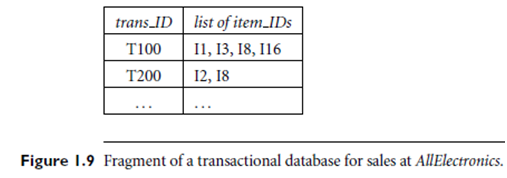SKEDSOFT
Introduction: In general, a transactional database consists of a filewhere each record represents a transaction. A transaction typically includes a unique transaction identity number (trans ID) and a list of the items making up the transaction (such as items purchased in a store).
The transactional database may have additional tables associated with it, which contain other information regarding the sale, such as the date of the transaction, the customer ID number, the ID number of the salesperson and of the branch at which the sale occurred, and so on.
 Examples:A transactional database for AllElectronics. Transactions can be stored in a table, with one record per transaction. A fragment of a transactional database for All Electronics is shown in Figure 1.9. From the relational database point of view, the sales table in Figure 1.9 is a nested relation because the attribute list of item IDs contains a set of items. Because most relational database systems do not support nested relational structures, the transactional database is usually either stored in a flat file in a format similar to that of the table in Figure 1.9 or unfolded into a standard relation in a format similar to that of the items sold table in Figure 1.6.
Examples:A transactional database for AllElectronics. Transactions can be stored in a table, with one record per transaction. A fragment of a transactional database for All Electronics is shown in Figure 1.9. From the relational database point of view, the sales table in Figure 1.9 is a nested relation because the attribute list of item IDs contains a set of items. Because most relational database systems do not support nested relational structures, the transactional database is usually either stored in a flat file in a format similar to that of the table in Figure 1.9 or unfolded into a standard relation in a format similar to that of the items sold table in Figure 1.6.
As an analyst of the AllElectronics database, you may ask, “Show me all the items purchased by Sandy Smith” or “How many transactions include item number I3?” Answering such queries may require a scan of the entire transactional database.
Suppose you would like to dig deeper into the data by asking, “Which items sold well together?” This kind of market basket data analysis would enable you to bundle groups of items together as a strategy for maximizing sales. For example, given the knowledge that printers are commonly purchased together with computers, you could offer an expensive model of printers at a discount to customers buying selected computers, in the hopes of sellingmore of the expensive printers. A regular data retrieval system is not able to answer queries like the one above. However, data mining systems for transactional data can do so by identifying frequent itemsets, that is, sets of items that are frequently sold together.